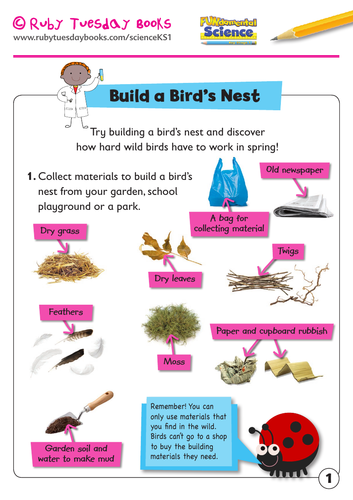

KS1 Science: Build a bird’s nest
Use this worksheet to carry out a hands-on investigation making a bird’s nest in a KS1 Science lesson. It complements our book ‘What’s the Season?’ from our FUNdamental Science series. For more information, downloads and to purchase our books, please visit www.rubytuesdaybooks.com
This download helps meet the following National Curriculum targets:
KS1: Working scientifically
Statutory requirements:
Using observations and ideas to suggest answers to questions.
Notes and guidance (non-statutory):
Pupils in years 1 and 2 should explore the world around them and raise their own questions. They should experience different types of scientific enquiries, including practical activities, and begin to recognise ways in which they might answer scientific questions.
Year 1: Animals, including humans
Notes and guidance (non-statutory):
Pupils should use the local environment throughout the year to explore and answer questions about animals in their habitat.
Year 1: Everyday materials
Statutory requirements:
Describe the simple physical properties of a variety of everyday materials.
Year 1: Seasonal changes
Statutory requirements:
Observe changes across the four seasons.
Year 1: Everyday materials
Statutory requirements:
Describe the simple physical properties of a variety of everyday materials.
Year 2: Living things and their habitats
Statutory requirements:
Identify that most living things live in habitats to which they are suited and describe how different habitats provide for the basic needs of different kinds of animals and plants, and how they depend on each other.
Year 2: Use of everyday materials
Statutory requirements:
Identify and compare the suitability of a variety of everyday materials, including wood, metal, plastic, glass, brick, rock, paper and cardboard for particular uses.
Notes and guidance (non-statutory):
Pupils might work scientifically by: comparing the uses of everyday materials in and around the school with materials found in other places (at home, the journey to school, on visits, and in stories, rhymes and songs); observing closely, identifying and classifying the uses of different materials, and recording their observations.
Something went wrong, please try again later.
Nicely laid out. Good questions for pupils to answer. Great activity.
Report this resourceto let us know if it violates our terms and conditions.
Our customer service team will review your report and will be in touch.